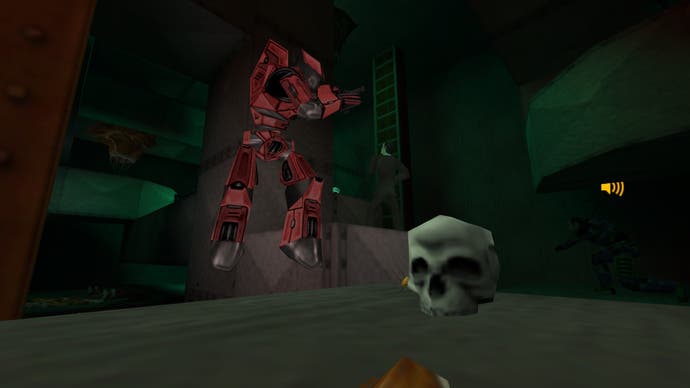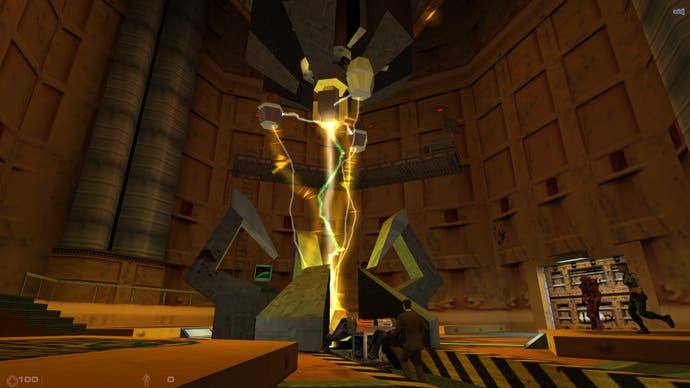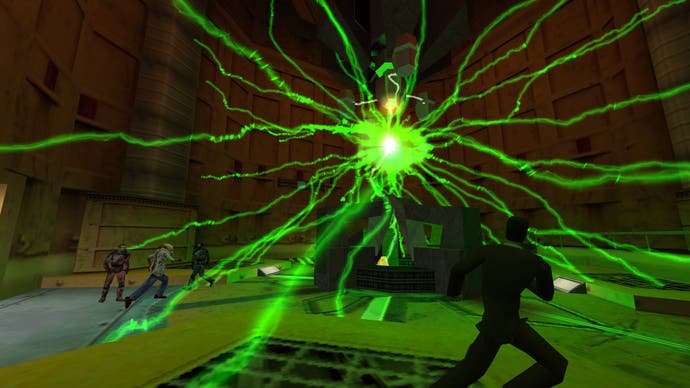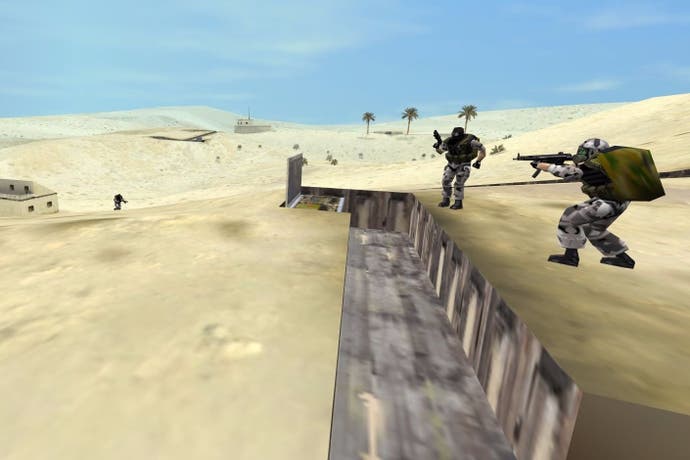The Half-Life mod that took 17 years to land on Steam
The story behind Sven Co-op.
It took Dan Fearon 17 years to get his game on Steam.
In early 1999, when Y2K threatened the world and Fatboy Slim's Praise You topped the UK singles chart, Fearon ran a fansite named Atomic Half-Life dedicated to Valve's then newly released sci-fi shooter. "I'd always been interested in coop games," he tells me. "I loved playing local coops like Rainbow Island on arcade machines when they were still around."
Much to Fearon's frustration, Half-Life didn't support cooperative play by default. And so, with a scant understanding of coding by way of crude experimentation in his youth, he set about changing that. Fearon - who went by the online pseudonym Sven Viking - designed his first cooperative Half-Life map and published it on his site. It was called svencoop.
"People were far more interested than I thought they'd be," he says. "Folk started asking how they could help with it. I couldn't work out a good way to have them help with the level itself, so I just suggested everyone submit their own levels that I'd then submit with the package. From there, it sort of became a community-driven thing."
On May 2 of that year, Sven Co-op, as that package became known, launched its first version 1.0, and although Fearon admits he didn't intend his mod to reach anyone beyond his immediate circle of online friends and acquaintances, as more and more servers cropped up, more and more mappers and modders appeared to take note. By December 1999, an established but ever-burgeoning Half-Life modding community had formed and Sven Co-op had earned its place at the heart of it. It clinched Mod of the Week on the IGN-owned Planet Half-Life website, and was featured in a number of specialist magazines such as PC Gamer and PC Zone.

One player who showed a particular interest in its early years was Dave McDermott. A self-confessed Half-Life fanatic, McDermott dived into the game's modding scene by way of popular mods such as Counter-Strike and Team Fortress Classic. He discovered Sven Co-op and quickly noticed that, even within the scope of its first year, it was fast evolving - breaking from the original conceit of simply adding co-op play to Half-Life, and increasingly becoming a means for modders to throw overpowered weapons, gaggles of monsters and all sorts of unorthodox items and features into the hallowed grounds of the Black Mesa research facility. He wanted to be part of it.
"Basically I started as one of those annoying players in the forums and I think I might have been 12 or 13 years old back then," says McDermott. "I came across Sven Co-op and got involved with making levels and I tried to make some weird stuff. I got on the team and the first level I made was Osprey Attack. I started doing some PhP stuff for the website and then got into the programing side a little more as the years progressed. I liked it so hopped on board there and helped out."
The years that followed saw Sven Co-op go from strength to strength. Its team grew into double figures with volunteers based all over the world, its recognition multiplied and updates ushered in scores of outlandish weapons, handy fixes, gruesome monsters and intricate maps. In 2002 Fearon and a core group of contributors were invited to Valve's Mod Expo in Dallas, Texas where they debuted an early version of Sven Co-op 2.0, and plans to release version 2.1 on the newly announced Steam beta were provisionally put in place later that year. It wasn't until the tail-end of 2003, however, that version 3.0 was released, heralding what some players consider the best iteration of Sven Co-op to this day - one Fearon tells me has been downloaded over one million times.
Plans to launch a Sven Co-op 2 utilising Half-Life 2's Source Engine were revealed, a dedicated team was formed, but a mix up with dates and obtaining the game's SDK meant it never materialised. Meanwhile, Sven Co-op's ever-growing popularity saw it capture third place on Fileplanet's Best Mods of 2003 list, runner-up on Mod of the Year 2004, and first place in ModDB's Best Action Mod category.
And then the bubble burst.

"I'm not gonna answer for other people, but for me I was getting to the point where I was losing motivation," says McDermott, who, by the mid-2000s, had become the mod's lead programmer. "When you can't find people to work on the stuff that you're in the middle of, it eventually gets to the point where you need to decide: are you going to wait longer and hope that someone shows up, or are you going to just cut your losses?"
As a hobbyist outfit, it's perhaps unsurprising that Sven Co-op's team suffered significant turnover at various junctures throughout its journey. Investment in such a project comes not only by way of server hosting fees and unpaid labour but also, most crucially, time. While many of its members went on to secure full time employment in the games industry, many others have simply lost interest and dropped out to pursue other things - a position much of the Sven Co-op team found themselves in shortly after the release of version 3.0. Talks with Valve regarding Steam access all but fizzled out, and the future of the entire project was in jeopardy. By 2007, dozens of fans took to the forums to express concern for the mod's well-being and where it was heading in the future.
"For some weird reason we had a few people come on board at that point," says McDermott. "And things started to greatly improve after that." One recruit that entered the fold at this stage was Josh Polito, a beta tester who now creates maps, provides voice acting, and helps with art projects and bug fixing. Alongside a number of other QA staff that were willing to turn their hand to other areas of development, he helped ensure Sven Co-op was pulled back on track and launched its much-awaited version 4.0 on Christmas Eve of 2008.
"I've been playing Half-Life since I was probably eight years old. I'm really happy with the fact that I get to work with the original files and I'm just really passionate about the whole thing," says Polito when asked what it meant to be involved in steering Sven Co-op away from the brink of closure. "It makes me happy to see people playing the thing and giving me compliments. It's nice to make something that you can see people enjoy."

With development back in full swing, Steam became the team's focus for a second time. McDermott recalls a chance conversation with another Half-Life modder who recommended he contact Valve directly and ask for an engine license. At the time, Greenlight hadn't long launched and while this was a more obvious way for Sven Co-op to access Steam, McDermott nevertheless contacted Alfred Reynolds, a Valve employee who once worked on Sven Co-op, and the process was set in motion. In 2013, Valve granted the Sven Co-op team access to its own custom adaptation of the Half-Life engine that would see version 5.0 feature on Steam as a free standalone game.
Before now, updates had been considered "mega releases", says McDermott, because delivering patches via mirror files on the Sven Co-op website is such a time-consuming ordeal. Arrival on Steam means these undertakings are not only more straightforward and more streamlined, but they can also be focussed on more practical things such as updating the game's UI or making it compatible with high resolution displays. Looking to the future, further customisation is what the team have their sights firmly set on.
"The goal is to make every last tiny bit of this game customisable and we're gonna try to make it something that can be a game generator for people to play with their friends on," says Polito. "I hope that opens the doors to game design for a lot of people out there. Currently there's a lot of stuff to get through to make your own game but I guess Sven Co-op could become this thing where you can go and test some things out and see what people like to do."
Sven Co-op's version 5.0 released on Steam on January 23 this year - 17 years and four days after Fearon first uploaded his svencoop cooperative Half-Life map onto his Atomic Half-Life fansite. It's since said to have shifted well over 900,000 copies.
Which brings us back around to the earlier question: what took Sven Co-op so long to achieve mainstream success? Since its inception in 1999, Sven Co-op has enjoyed hundreds of thousands of inventive players who've thrived in its no holds barred, anything goes approach to Half-Life co-op - an ethos that's formed the basis of its dedicated community. Perhaps a better question, then, is: what took everyone else so long to discover Sven Co-op?

McDermott, Polito and Fearon have been overwhelmed by the reception their game has had since launching on Valve's digital distribution platform, and have delighted in the number of players old and new putting its customisation options to the test. Being on Steam now therefore marks yet another fork in Sven Co-ops long and enduring path, and is not simply a measure of its success. Sven Co-op represents a community - a fact perfectly illuminated by the fact version 5.0 is dedicated to programmer Brent Holowka who died unexpectedly of heart failure aged just 37 in October last year. As we speak over Skype, it's midnight at my end in Glasgow, 4pm at Polito's end on the west coast of America, 9am at Fearon's end in Brisbane, and 7pm at McDermott's end on the east coast of the States - a measure of how far reaching Sven Co-op's membership spans.
Which isn't always a good thing, Fearon tells me.
"For the 3.0 release, we were really concerned about leaks and anything getting out earlier than planned," he says. "We'd been working pretty hard to get it released on Christmas so I'd actually been up for about 24 hours trying to get the last things sorted out. We'd sent the install files to team members all over the world - Europe, America, Australia - and had given them the same time for when it was supposed to go public.
"I'd then planned to go to sleep and wake up on Christmas morning, when I'd post the news and do the last few things. I then got an email just before I went to bed from someone who was contributing at the time saying, oops, I didn't realise about the time, I've released it now. As I say, at the time we were fairly concerned about a version leaking before the official date so we then had to quickly rally round and release there and then.
"After we'd released, I had to play the game - with everyone playing I wanted to make sure everything went smoothly and see what people were doing with all the new things. I then played for a number of hours, eventually went to sleep, and slept through the rest of Christmas. Unfortunately when I got up, something in my neck gave out and I was in a neck brace for weeks after that. That might've been building up for some time but I think that might've pushed me over the edge!"

